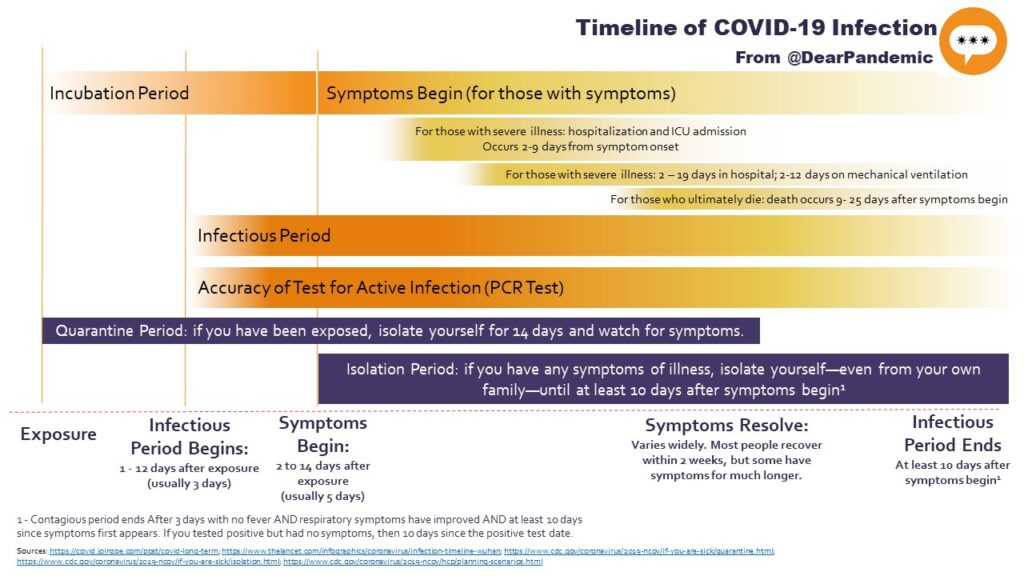For today’s #ThrowbackThursday, we revisit a post from May 4th about the timeline of infection.
A: This timeline, which we adapted from several sources, visualizes the incubation period and infectious period (also called contagious period), along with the timeline for seeing symptoms, timing for a reliable PCR test, and the typical timeline to hospitalization and death, for those who have severe disease.
We have also included how a quarantine or isolation period would line up with your calendar in case of an exposure or in case of symptoms appearing.
Here are the basics:
The INCUBATION period is the time from when someone is infected until symptoms develop. For COVID-19, emerging evidence suggests that the incubation period can range from 2-14 days (5ish days is typical).
The INFECTIOUS period, or contagious period, is the time period during which someone infected with virus can transmit it to other people. Emerging evidence demonstrates that for COVID-19, the infectious period starts 2 days prior to the appearance of symptoms and that individuals with COVID-19 are most infectious at day 1 of symptoms. It lasts for at least 10 days.
A test for active infection (the nasal swab kind, also called a PCR test) detects the presence of viral material in your sinuses, and it relies on there being enough viral material up there to detect. So testing accuracy follows the same timeline as the infectious period. You may get false negative tests early on in your infection, when there is not yet a lot of viral material. As the virus makes more and more copies of itself, you’re more likely to get an accurate test AND shed more virus–i.e., become infectious.
For those who get symptoms, the symptoms begin between 2 to 14 days after exposure, usually around 5 days. For those who go on to have severe illness, hospitalization often occurs several days after symptoms start, and hospital stays range from 2 to 19 days. For those who ultimately die of COVID-19, the time from the first symptoms to death is around 9 to 25 days.
We have also included the timing of the recommended period to QUARANTINE yourself after you’ve been exposed to someone who has COVID-19. Quarantine is what happens when you separate yourself after exposure to wait out the incubation period. Quarantine for 14 days after exposure, and watch for symptoms.
If you do become symptomatic, you need to ISOLATE yourself for at least 10 days after the first symptoms appear + you have had 3 days with no fever + your respiratory symptoms have begun to improve. Isolation is when a sick person is kept separate from others in order to prevent others from becoming sick too.
If you test positive but never become symptomatic, you should isolate yourself for 10 days following the date of your test. If you aren’t symptomatic (yet), and you have had a test and are waiting for results, you should isolate at least until your test result comes back so that you don’t expose anyone else while you’re waiting to find out!
A few related implications:
1. With each subsequent relaxation of physical distancing policies we’re going to face a two(ish) week lag for new symptomatic cases to appear and a 2+ week lag for severe cases to appear, and longer for deaths to start to appear.
2. As caring citizens interested in protecting others, we’ll be wise to note that infected individuals are most infectious at the onset of symptoms (assuming, of course, that symptoms appear). So at the first appearance of ANY COVID-19 like symptoms we should be extra vigilant to socially isolate ourselves from others.
For more great epidemiology 101 info, we recommend the (free!) COVID-19 contact tracing course on Coursera.
It provides five(ish) hours of amazing content, broken out into very small chunks (10-15 minute intervals). It’s likely to become a pre-req for many of the contract tracing workforces being hired right now, and is intentionally designed to help laypeople become literate about both the Coronavirus and public health basics.



